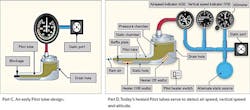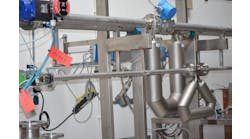Figure 1. The locations an desings of speed- and altitude-detecting Pitot tubes (Courtesy of Gregory Leptoukh of NASA, Aviation Week and FAA's "Instrument Flying Handbook.")
Q: In your book, Instrument Engineers' Handbook, your examples all seem to be related to fluids and not dust-laden gas (as in flue gases). I'm interested in sealed sensors. Who manufactures them? We have challenges from dust particles affecting total air measurement on our forced draft (FD) fans. The dust comes from recirculating lines that feed back to the FD fan suction, which we use for dew point control during boiler start-up.
Richard Mahupete
[email protected]
A: Unfortunately, I can't help you. I've been looking for an instrument for almost the same application for 20 years, but in vain. In my case, we have a big gas duct 11 feet in diameter carrying gas that has about 0.5% of fine coke dust at 1,100 °F. This gas, a mixture of CO, SO2, amine, waste fuel gas (CH4, H2, etc.) and flue gas, comes from a coker at very high velocity, and is fed to a CO boiler used as incinerator. We have three ducts that are lined with 4 in. of slag.
I was told that ultrasonic flowmeters do not work at high temperatures, hindered by the four inches of slag and by big swings in the gas flow that occur frequently due to process upsets upstream. In the past, these have caused trips and explosions in the precipitators of the CO boiler downstream, and also black gas diversions for over 24 hours. I will be watching the replies to this question closely.
Gerald Liu, P. Eng.
[email protected]
A: You could measure fan power (not current!) to get a reasonable measure of flow. Modern motor protection relays (e.g., Multilin) can be set up to measure power.
Simon Lucchini
[email protected]
A: Many of the standard manufacturers — Rosemount, Endress+Hauser, ABB, Honeywell — build transmitters that have sealed sensors. But to be able to give a better answer you need to supply more detailed information, such as use of the instrument, process variables, type of dust contaminants and concentrations, etc., since some applications may have easy solutions, while others may be more complex. See these links here and here.
Alejandro Varga
[email protected]
A: You might try using a thermal mass flow sensor that inserts into your stack connected to a transmitter.
M. Conella
[email protected]
A: You did not give the duct/pipe size, operating temperature, presence of slug build-up, etc. Therefore, the options below are uncertain. If your temperature is less than 500 °C, consider a thermal probe, and obtain a bid for a retractable unit (bit.ly/1nqAfHA). If there is no slug buildup, but the temperature is high, consider a Doppler cross-correlation ultrasonic sensor (bit.ly/1kFHmIy).
If your duct/pipe is large (meters), segmental wedge is an option. If slug build-up is heavy, purge the pressure taps. If not, use chemical seals with ceramic diaphragms and syltherm filling in the capillaries. If all you need is repeatability, you can try a retractable Pitot with strong purging, such as this one.
Béla Lipták
[email protected]
Q: In a past column, you wrote about air transportation safety and the role of automation that should and could be increased to improve it. You also mentioned something about the role of Pitot tubes and their features. Could you elaborate?
This column is moderated by Béla Lipták, automation and safety consultant and editor of the Instrument and Automation Engineers' Handbook (IAEH). If you have an automation-related question for this column, write to [email protected].
H. Crowney
[email protected]
A: You are right. In an age when we can send robots to Mars and drones to chase terrorists, it is strange that we cannot automatically prevent pilots from attempting to land at the wrong speed, or automatically stop ferry captains from turning into high-speed currents at sharp angles, or automatically prevent drivers from switching lanes when a high-speed car is coming in that lane. In short, it is hard to believe how strong our “manual culture” is, and how many Fukushimas it will take before we accept the fact that 45 minutes between the earthquake and the arrival of the tsunami is enough to flood the reactors with cooling water only if it is done automatically, but that this will not occur if we expect it to be done by panicked operators waiting for the approval of CEOs.
While Pitot tubes are used in other industries, where they are considered to be one of the less accurate and reliable flow sensors, in the field of aviation, they play a critical role in measuring both the speed and the altitude of airplanes. Thousands of these Pitot detectors are still in use on operating airplanes.
Figure 1 shows the locations of the Pitot tubes (Part A) that inform the captain and the first officer of the speed and altitude of the plane. A third sensor is provided as a backup in case all the others fail. Part B shows the physical appearance of a Pitot unit, and Part C the cross section of an early design, where the differential gauge reads only the difference between the static and the Pitot pressure, and was scaled to read velocity. Part D shows the design today. Here, the air speed indicator is the same as before, but in addition to velocity, the static pressure is also read in units of altitude (altimeter), and the vertical speed of the plane is also detected by indicating the rate of change in the altitude (static pressure).
The Pitot tube itself is provided with a drain hole and with a heater for deicing. Interestingly, the deicing heater is not started automatically by outside temperature, but is turned on manually by the pilot. In addition, there is no way for the pilots to know if the Pitot tube is plugged, although a simple fiber-optic sensor could detect that, and purge cleaning could automatically be started as soon as a plug is detected.
These are some of the reasons why I believe that the aviation industry could take better advantage of safety automation.







